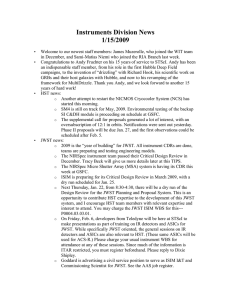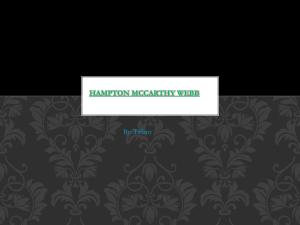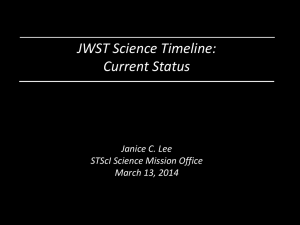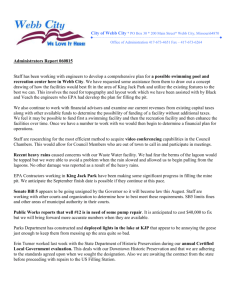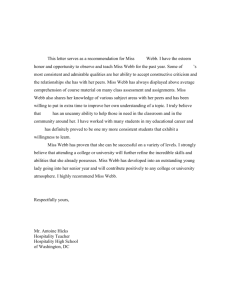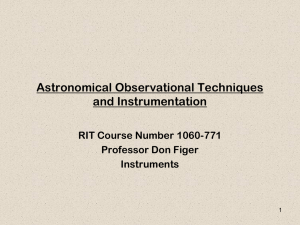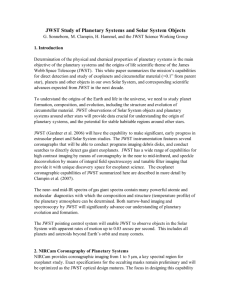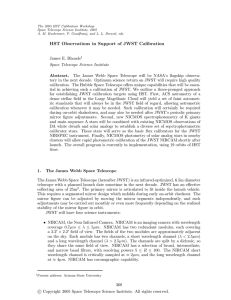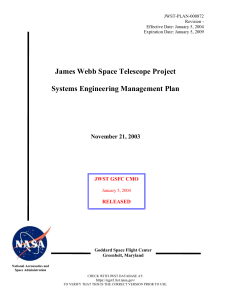JWST and STEM Educa*on - Stewart Middle Magnet School
advertisement
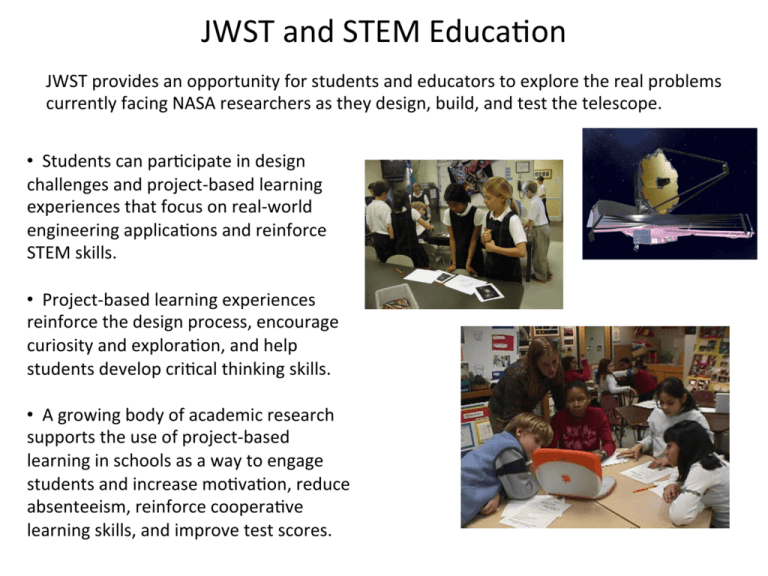
JWST and STEM Educa-on JWST provides an opportunity for students and educators to explore the real problems currently facing NASA researchers as they design, build, and test the telescope. • Students can par-cipate in design challenges and project-­‐based learning experiences that focus on real-­‐world engineering applica-ons and reinforce STEM skills. • Project-­‐based learning experiences reinforce the design process, encourage curiosity and explora-on, and help students develop cri-cal thinking skills. • A growing body of academic research supports the use of project-­‐based learning in schools as a way to engage students and increase mo-va-on, reduce absenteeism, reinforce coopera-ve learning skills, and improve test scores. JWST and STEM Educa-on The components of a JWST project-­‐based learning experience would include: • Learning by Doing • Crea-ng Products/Solving Problems • Student Voice & Choice • Higher Order Thinking/Skills Essen-al for STEM Careers (Apply, Analyze, Evaluate, Create, Design) • Thema-c/Interdisciplinary • ASen-on to Learning Styles • Modern Learning Tools (technology, etc.) • Real World Connec-ons • Reflec-on & Processing • Increased Awareness of NASA Careers JWST and STEM Educa-on To most effec-vely design and disseminate a JWST project-­‐based ac-vity for the educa-on community, we will work within STScI's proven educa-on infrastructure already established for the HST mission. • A key component of this infrastructure is the Hubble Educa-on Program, which provides up-­‐to-­‐date space science content and educa-on resources to the formal and informal educa-on communi-es. • Hubble Educa-on resources are u-lized by K-­‐12 educa-on ins-tu-ons in all 50 states, including 42 of the 100 largest school districts in the United States. • We will follow a top-­‐down approach by working with school districts, agencies, and other organiza-ons with which we already have an established partnership. Blake High School students present a Hubble-inspired dance performance on-stage during an ERO family event in Tampa, Florida. Students pose in front of their project, the “Hubble Cube,” at the San Bernardino County Museum in California. A student poses in front of her Hubble-inspired research project during an ERO family event at Stewart Magnet Middle School in Tampa, Florida. Students from the Odyssey School pose in front of their model of the Pillar in the Carina Nebula during an ERO family event at the Maryland Science Center in Baltimore, Maryland. Middle school students pose with their model of a spiral galaxy that includes infrared solar systems scattered throughout its arms. A California student poses with her project, a model of JWST. First grade students pose with their tessellation project featuring JWST’s primary and secondary mirrors. A California student poses with his “JWST in a Bottle” project. The James Webb STEM Innovation Project Based upon the success of the Hubble Early Release Observations (ERO) Student Pilot Project, the Space Telescope Science Institute’s Office of Public Outreach has developed the James Webb STEM Innovation Project (SIP) – an interdisciplinary, standards-based project that focuses on the engineering aspects and potential scientific discoveries of JWST, while incorporating elements of project-based learning. We have developed the SIP to promote enthusiasm for space exploration, introduce the education community to JWST, and engage the education community in the adventure of scientific discovery to be enabled by the James Webb mission. The SIP provides an opportunity for students and educators to explore the challenges currently facing NASA researchers as they design, build, and test JWST. Students in participating schools use skills from multiple subject areas to research an aspect of the JWST’s design or potential science and create models, illustrated essays, or technology-based projects to demonstrate their learning. By structuring standards-based educational activities around the observatory’s design and potential science, students are able to work in cooperative teams as engineers and scientists do, and participate in interdisciplinary projects and design challenges that reinforce STEM skills as they solve real-world challenges. The SIP began as a pilot effort in two states – New York and California. We continue to work closely with two education consultants in each of these states. Currently, the SIP is underway in all 50 states in the U.S. and we continue to recruit additional schools and institutions to participate. Examples of Student Work: http://amazing-space.stsci.edu/events/jwst-sip/jwst-sip-intro.pptx Astronomy powerpoint that has information about the James Webb: http://amazing-space.stsci.edu/events/jwst-sip/astronomy-and-jwst.pptx Websites that you may wish to visit include: 1. Space Telescope Science Institute http://www.stsci.edu/portal/ There are two routes to find info: check News and Education for JWST and check current missions for JWST. There are fliers under document archives. 2. James Webb Space Telescope at NASA http://www.jwst.nasa.gov/ Has status, news, the science, animations and videos about the Webb. There are 20 episodes of Behind the Webb podcasts. In the Section for Educators under formal education, there are lesson plans, challenges, math problems, games, and links to other sites like Amazing Space and Cool Cosmos. In the Section for Educators under informal education, there is a list of e-clips (short videos) that you can filter by age group 3. HubbleSite http://webbtelescope.org/webb_telescope/ Gives Webb's Nuts and Bolts. Gives a rundown of facts. Has a web cam to highlight progress. Shows current mission status. There are free downloads for I pads from the site. 4. Cool Cosmos http://coolcosmos.ipac.caltech.edu/ Has infrared lesson plans, posters, and printouts. Has a link to a teach astronomy section with videos. Has a link to NASA wavelength which has interactive simulations, planetarium shows, graphic novel resources and science games. 5. Amazing Space http://amazing-space.stsci.edu/ Gives background on the Webb in the explorations section about Telescopes from the Ground Up. Has graphics to support the Webb story in the Telescope from the Ground Up section. Has an explanation for the reason Webb will be so far from Earth at LaGrange Point 2. Has information about comparing telescope mirror sizes. Has background videos for galaxies. Has pictures about stars and stellar evolution. Has teaching tools by topic-e.g. galaxies, electromagnetic spectrum, light, and color. Website that shows JWST Deploy Animation http://svs.gsfc.nasa.gov/vis/a010000/a010600/a010660/index.html http://www.jwst.nasa.gov/videos_deploy.html Videos on YouTube http://www.youtube.com/watch?v=WFhR5eeTrXE http://www.youtube.com/watch?v=jlpjz93zhVQ Infrared video Infrared Video: More Than Your Eyes Can See with Dr. Michelle Thaller. This site allows downloading to your laptop http://coolcosmos.ipac.caltech.edu/videos/more_than_your/index.html
